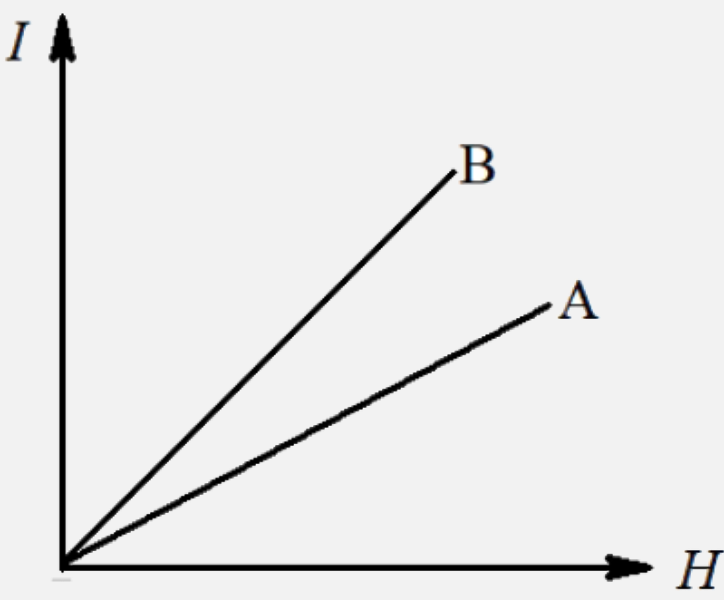When a ferromagnetic material goes through a hysteresis loop, the magnetic susceptibility
has a fixed value
may be zero
may be infinity
may be negative
The correct Answer is:B, C, D
To solve the question regarding the behavior of magnetic susceptibility when a ferromagnetic material goes through a hysteresis loop, we will analyze the properties of the hysteresis loop and the definition of magnetic susceptibility step by step.
1. Understanding Hysteresis Loop:
- The hysteresis loop represents the relationship between the magnetization (I) of a ferromagnetic material and the external magnetic field intensity (H). The x-axis represents the magnetic field intensity (H), while the y-axis represents the magnetization (I).
2. Defining Magnetic Susceptibility:
- Magnetic susceptibility (χ) is defined as the ratio of magnetization (I) to the magnetic field intensity (H):
χ=IH
3. Analyzing Points on the Hysteresis Loop:
- Point B: At this point, the magnetization (I) is positive, and the magnetic field intensity (H) is zero.
- Since H is zero, the susceptibility (χ) tends to infinity:
χ→∞(as H→0)
- Point C: Here, the magnetization (I) is positive, but the magnetic field intensity (H) is negative.
- Thus, the susceptibility (χ) will be negative:
χ<0(since I>0 and H<0)
- Point D: At this point, the magnetization (I) is zero, and the magnetic field intensity (H) is negative.
- Therefore, the susceptibility (χ) will be zero:
χ=0H=0(where H<0)
4. Conclusion:
- From the analysis of the points on the hysteresis loop:
- At point B: χ tends to infinity.
- At point C: χ is negative.
- At point D: χ is zero.
- Thus, the magnetic susceptibility is not fixed and can take on different values throughout the hysteresis loop.
5. Final Answer:
- The correct options based on the analysis are:
- Magnetic susceptibility may be 0 (Option 2).
- Magnetic susceptibility may be negative (Option 4).
- Magnetic susceptibility may be infinity (Option 3).
- Therefore, the magnetic susceptibility is not a fixed value (Option 1 is incorrect).
- The hysteresis loop represents the relationship between the magnetization (I) of a ferromagnetic material and the external magnetic field intensity (H). The x-axis represents the magnetic field intensity (H), while the y-axis represents the magnetization (I).
- Magnetic susceptibility (χ) is defined as the ratio of magnetization (I) to the magnetic field intensity (H):
χ=IH
- Point B: At this point, the magnetization (I) is positive, and the magnetic field intensity (H) is zero.
- Since H is zero, the susceptibility (χ) tends to infinity:
χ→∞(as H→0)
- Point C: Here, the magnetization (I) is positive, but the magnetic field intensity (H) is negative.
- Thus, the susceptibility (χ) will be negative:
χ<0(since I>0 and H<0)
- Therefore, the susceptibility (χ) will be zero:
χ=0H=0(where H<0)
- From the analysis of the points on the hysteresis loop:
- At point B: χ tends to infinity.
- At point C: χ is negative.
- At point D: χ is zero.
- Thus, the magnetic susceptibility is not fixed and can take on different values throughout the hysteresis loop.
- The correct options based on the analysis are:
- Magnetic susceptibility may be 0 (Option 2).
- Magnetic susceptibility may be negative (Option 4).
- Magnetic susceptibility may be infinity (Option 3).
- Therefore, the magnetic susceptibility is not a fixed value (Option 1 is incorrect).
Topper's Solved these Questions
- MAGNETIC PROPERTIES OF MATTERBOOK - HC VERMA ENGLISHCHAPTER - MAGNETIC PROPERTIES OF MATTEREXERCISE - Exercise
9 Videos
- MAGNETIC PROPERTIES OF MATTERBOOK - HC VERMA ENGLISHCHAPTER - MAGNETIC PROPERTIES OF MATTEREXERCISE - Short Answer
6 Videos
- MAGNETIC PROPERTIES OF MATTERBOOK - HC VERMA ENGLISHCHAPTER - MAGNETIC PROPERTIES OF MATTEREXERCISE - Objective 1
7 Videos
- MAGNETIC FIELD DUE TO CURRENTBOOK - HC VERMA ENGLISHCHAPTER - MAGNETIC FIELD DUE TO CURRENTEXERCISE - questions for short answer
12 Videos
- OPTICAL INSTRUMENTSBOOK - HC VERMA ENGLISHCHAPTER - OPTICAL INSTRUMENTSEXERCISE - Question for short Answer
12 Videos
Similar Questions
The magnetic induction and magnetising field intensity in a sample of magnetic material are B and H respectively . The magnetic susceptibility of the material is
View SolutionFerromagnetic material and non-magnetic material
View SolutionWhen a ferromagnetic material is heated above its Curie temperature , the material
View SolutionThe following figure shows the variation of intensity of magnetisation I versus the applied magnetic field intensity H, for two magnetic materials A and B

Which of the material have a larger susceptibility for a given field at constant temperature?
View SolutionA susceptibility of a certain magnetic material is 400. What is the class of the magnetic material?
View SolutionA: Above curie-point a ferromagnetic substance behaves as a paramagnetic substance.
R: Magnetic susceptibility of a diamagnetic substance increases with rise in temperature.
View SolutionA paramagnetic material has 1028a→ms/m3. Its magnetic susceptibility at temperature 350K is 2.8×10−4. Its susceptibility at 300K is :
View SolutionRelative permeability of iron is 5500, then its magnetic susceptibility will be
View SolutionAssertion: Above Curie temperature, a frerromagnetic material becomes paramagnetic.
Reason: When a magnetic material is heated to very high temperature, it loses its magnetic properties.
View SolutionAt a temperature of 30∘C, the susceptibility of ferromagnetic material is found to be 'χ' its susceptibility at 333∘C is
View Solution
